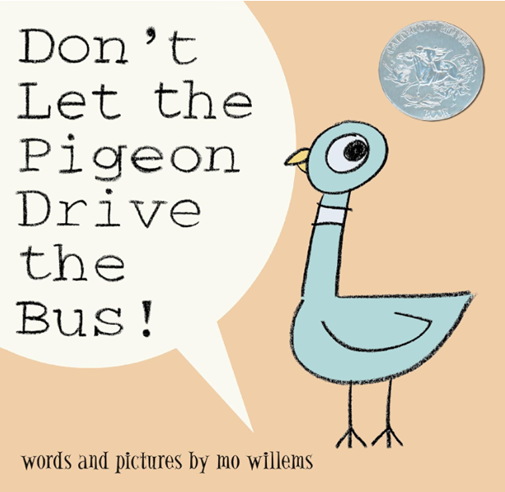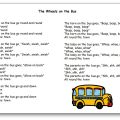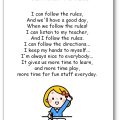Author: Mo Willems
Illustrator: Mo Willems
Publisher: Hyperion Books for Children
Year: 2003
Language: English
Type of resource: Illustrated picture book with dialogue
Themes: Emotions, frustration, rules and prohibitions, humor, transportation
Age range: 4–10 years old
School levels: Preschool, Grade 1, Grade 2, Elementary (K–5)
Main learning objective: Understand and express emotions in English through an everyday situation
Main language objective: I can understand and say simple sentences to express what I want or feel.
Summary of the Book
A bus driver leaves for a short break and gives the readers one important mission: do not let the pigeon drive the bus while he’s gone. The moment he leaves, the pigeon tries every possible trick to convince the reader to hand over the wheel. He begs, argues, promises, gets angry, plays the drama card, and even shouts… but with no success. When the driver returns, relieved that the pigeon hasn’t driven the bus, the bird spots a truck and is already dreaming about driving another vehicle. This interactive dialogue showcases the persuasive strategies of an energetic and determined character.
Culture and Vocabulary
The book uses a form of humor typical of Anglo-American children’s literature, where the reader is directly involved as a character in the story. The absurd premise (a pigeon wanting to drive a bus) creates instant engagement and invites young learners to interact. The “breaking the fourth wall” style and exaggerated expressions are hallmarks of contemporary North American picture books. The story also gives a glimpse of everyday American life (city buses, conversational exaggeration) while introducing the idea of rules and responsibility.
Transportation vocabulary: bus, driver, truck
Everyday nouns: bus, driver, pigeon, block, bucks (informal for “dollars”)
Action verbs: drive, steer, go, play, let, leave, watch, bet, give
Modal and auxiliary verbs: can, will, would, did
Adjectives: careful, fair, big
Expressions for wishes or frustration: Can I…? I never get to do anything! It’s not fair! I have dreams, you know!
Idiomatic expressions: I’ll be your best friend; Just once around the block; What’s the big deal?
Grammar and Structures
- Imperative: “Don’t let the pigeon drive the bus!” – Introduces the negative imperative, perfect for giving simple instructions.
- Interrogatives with “can”: “Can I drive the bus?” – A clear model for making polite requests.
- Contracted forms: “He’d never leave” – Familiarizes learners with common spoken contractions.
- Use of “let” + infinitive: “Let me drive the bus” – Useful for expressing permission or insistence.
- Exclamatives: “What’s the big deal!?” / “LET ME DRIVE THE BUS!!!” – Highlights intonation and emotion in speech.
- Present simple: “I have dreams, you know!” – Shows how to state opinions or facts.
- Future with will: “I’ll be your best friend” – Introduces promises or likely consequences.
Phonology
- Sound repetition: “Vroom-vroom vroomy vroom-vroom!” – Encourages oral production and the use of onomatopoeia.
- Expressive intonation: “LET ME DRIVE THE BUS!!!” – Ideal for exploring variations in tone and emotion.
- Emotional emphasis: “NO?” – Good for practicing rising intonation for surprise or frustration.
- /v/ sound: in “Vroom,” “drive” – Helps distinguish common but challenging sounds for French speakers.
- Diphthongs: in “go,” “no,” “know” – Supports oral fluency practice.
- Modal emphasis: “CAN I drive the bus?” – Draws attention to the modal verb’s role in the sentence.
Teaching Suggestions
Before Reading
- Show the book cover and ask: Who is this? What is he doing?
- Mime the bus driver and have students say: Don’t let the pigeon drive the bus!
- Introduce the word pigeon and a few transport-related verbs (drive, go, stop).
During Reading
- Read the story in two voices: the teacher reads the bus driver’s lines, a student reads the pigeon’s lines.
- Encourage students to interact by responding “No!” each time the pigeon asks to drive.
- Identify the pigeon’s emotions on each page.
After Reading
- Draw a vehicle and ask: Can the pigeon drive it?
- Reenact the scenes using puppets or masks.
- Match the pigeon’s sentences to the corresponding emotions (anger, hope, sadness…).
Grammar Mini-lesson
- Practice the negative imperative with Don’t… and rehearse classroom instructions (Don’t open the door, Don’t run, etc.).
- Practice forming questions with Can I…? to ask for permission.
- Express prohibition and refusal with No, You can’t, Don’t do that.
Differentiation
This book lends itself easily to differentiation according to language level. For beginners, focus on the illustrations, gestures, and intonation to help them follow the story without difficulty. Prioritize oral activities, mime, and yes/no responses. More advanced students can reformulate the pigeon’s arguments, create new attempts, or write speech bubbles. Independent learners can role-play the scene in pairs or invent a sequel where the pigeon wants to drive another type of vehicle.
Cross-Curricular Connections
Social and Emotional Learning (SEL): Class discussion on managing frustration, respecting rules, and learning to say “no.”
Visual Arts: Draw the pigeon in different vehicles or design a “Don’t let…” poster.
Physical Education / Drama: Mime games based on the pigeon’s emotions.
Media Education: Create a short video where students act out the scene.
Song: “The Wheels on the Bus” to reinforce transportation vocabulary.
Project Ideas
Class Project: Imagine a new silly rule (Don’t let the pigeon eat ice cream!) and create a mini picture book in English with repetitive sentences and illustrations. Reuse prohibition structures and the modal can by making illustrated posters and writing the pigeon’s persuasive arguments. This collaborative project can lead to a class exhibition.
Exploring Other Books: Read Don’t Let the Pigeon Stay Up Late! or The Pigeon Wants a Puppy to extend the pigeon’s adventures and work on new language functions (telling the time, expressing wants, talking about animals).
Conclusion
Don’t Let the Pigeon Drive the Bus! is an interactive, lively, and humorous book that immediately captures children’s attention. It provides an excellent opportunity to work on key language functions such as making requests, refusing, prohibiting, and expressing emotions. With its simple structure and expressive illustrations, it is a highly effective resource for teaching English in primary school, from preschool through upper elementary. The book also offers many creative and cross-curricular teaching possibilities, making it a versatile choice for ESL classrooms.





